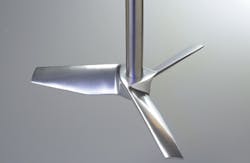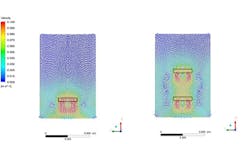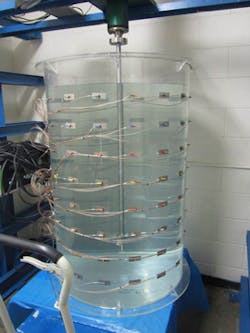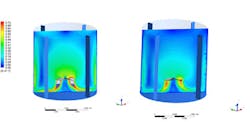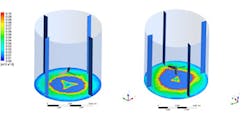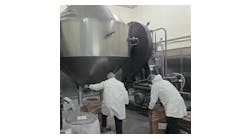How computational fluid dynamics is applied to mixer design
The use of computational fluid dynamics (CFD) modeling software has grown quickly over the last two decades based on the availability of increasing computing power. Commercial software can be used to predict flow patterns in both simple and complex geometries. The output from these models, when analyzed by a CFD engineer experienced in the field of fluid mixing, is an important tool in industrial mixing design.
Nevertheless, a clear understanding of fundamental fluid mechanics is required to properly use CFD. This includes applying 1) the correct fluid model to the situation (laminar or turbulent); 2) sound volume-meshing techniques; 3) the appropriate boundary conditions to the given geometry and 4) experimental validation of results. Thus, CFD is best handled by experienced engineers that understand the latest analysis tools and are well versed in mixing technology.
Mixers are modeled using either 2D or 3D CFD techniques. The first applies only to axi-symmetric installations, i.e., round tanks that are fully baffled, with a mixer mounted vertically on the center. Knowledge of the impeller outlet velocity profile is required for 2D modeling, which is obtained through experimental techniques such as laser Doppler velocimetry (LDV).
Flow pattern effects
While 2D modeling only gives a quick approximation of the mixing tank flow pattern in the vertical plane, it supports rapid decisions on impeller placement and number of impellers required, especially in low-viscosity blending applications.
Modeling in 3D takes into account impeller geometry and its rotation. However, the flow field predicted through 3D CFD should still be validated with LDV results. A variety of mixer geometries, including angular-mount and side-entry, or if there are multiple mixers within a tank, can be modeled. Compared to 2D CFD, 3D is more useful for comparing initial mixer design options and for process troubleshooting.
In addition, 3D CFD can determine the flow-pattern effect of both inlet and outlet flows entering a tank. This analysis can help determine whether an inlet stream will short circuit or have a negative effect on the mixer-established flow pattern.
Practical limitations
An experienced CFD engineer can use CFD modeling to predict process variables such as blend time or cloud height for solids suspension applications. In addition, work has been done to date using CFD to predict gas distribution in gas-liquid dispersion applications. Although this and related work is possible using CFD, the time required to run the models increases significantly due to the nature of the complex models required. This often requires multiple computers operating for days rather than hours to obtain a single predicted answer. In addition, experimental validation must be completed to verify the findings of these complex models. Thus at present, it is typically recommended that experimental methods (lab-scale or pilot-scale testing) be used to predict mixing performance for complex mixing applications.
CFD aids in proper evaluation of mixer design and application, but it can’t be used as a standalone design tool. Mixer design not only includes optimizing the impeller design but also includes mechanical design, tank structural design, tank internals design (i.e., baffles, coils) and others. However, when properly applied, CFD can be used effectively towards optimizing mixer process design as shown in the examples.
Practical CFD examples in mixer design
In the first example, 2D CFD analysis demonstrated that, for a given mixer application, two impellers are better than one.
Low viscosity blending of two miscible liquids is a common application in a variety of industries. Although various mixer configurations are possible, the most efficient use of energy follows from having the mixer on center, with wall baffles, using a hydrofoil impeller such as the SPX LIGHTNIN brand A510 (See Figure 1).
In some cases, due to space limitations, tall tanks with high aspect ratios (i.e., high liquid height-to-tank diameter ratio) are used. The entire tank contents must blend in a given amount of time. In such cases, either a single- or dual-impeller installation must be chosen. Differences between flow patterns of the two designs can be demonstrated via 2D CFD. Such a comparison is shown in Figure 2.
For a single impeller, a faster rotational speed is used. Although adding a second impeller adds initial cost, the tank blends faster with two impellers due to a better distribution of velocities and energy dissipation with dual impellers, even though installed motor power in both cases modeled would be the same.
If the goal was power savings, adding the second impeller would reduce the installed power for the mixer while leading to the same blend time as the single impeller mixer. Experimental work using three-dimensional conductivity probes (Process Tomography as shown in Figure 3) can be conducted on scaled down versions of each set up to show the effectiveness of having two impellers installed versus one in a tall tank.
Do the comparisons needed for mixer scale-up
Solids suspension is a common application in both industrial and municipal markets. Suspension is achieved by maintaining a certain level of mean velocities and turbulent eddies within the fluid near the bottom of the tank. CFD can verify that velocity and energy plots from one scale to the next are similar and, therefore, whether performance from one scale to the other will be similar.
The example involves a 3.8 m3 fully baffled round tank with a square batch (i.e., liquid height to tank diameter ratio is 1.0). The plant is interested in scaling the process up to a 148:1 scale-up factor. The mixer duty is suspension of lightweight solids. The same suspension level is required in the larger-scale vessel as in the smaller-scale one. Note that the mixer in the small scale was working successfully prior to this scale-up.
A common approach for the scale-up of a solid suspension application is to maintain geometric similarity from scale to scale and to also scale up on power per unit volume or specific power. It is also important to compare flow regimes in both scales. In this instance, both cases had low viscosity fluids and thus the Reynolds number in each case was fully turbulent. In fluid mechanics, the Reynolds number (Re) is a dimensionless number that gives a measure of the ratio of inertial forces to viscous forces. If this is not the case, CFD cannot be easily used to compare one case to the other, especially if the fluid regime changes upon scale up. The impeller modeled in both scales is the SPX LIGHTNIN brand A510 impeller (shown in Figure 1).
The velocity field comparison is shown in Figure 4. Figure 5 shows the energy dissipation comparison.
In both cases, the full-scale design is shown to the left and the smaller-scale design is at right. Both plots are scaled to the same level of velocity and energy dissipation, for a fair-results comparison. The scaled-up mixer yields slightly higher velocities than the smaller scale mixer, due to the increase in tip speed from small to large scale. The energy dissipation plots are also similar, with higher levels of turbulence directed towards the bottom of the vessel — required to suspend solids in a similar fashion from scale to scale.
Although not modeling actual cloud height, this analysis can be used to justify a scale-up method provided flow regimes remain constant from one scale to the next.
CFD misused to predict solids suspension performance
The A510 impeller has a variety of specific blade shapes available, with each combination yielding a different impeller power number. As the angle at the end of the blade is reduced (tip chord angle), the power number for the impeller is reduced. Thus to maintain power at a given diameter, the lower power number impeller must rotate faster.
In this case, two A510 impellers were compared in a suspension test at the same power level. In this case, the A510 with the higher tip chord angle required 25% less power than the A510 with the lower tip chord angle to yield the same level of suspension within the vessel. A 3D CFD model was performed for each case.
Figure 6 shows the velocity vector comparison and Figure 7 shows the eddy dissipation comparison at the bottom of the test vessel. From a first glance at the velocity vectors, they appear to be approximately the same while the eddy dissipation plots are quite different. Although velocity plots are the most commonly used CFD output for comparison, they don’t always lead to the correct conclusion (in this case, that equal velocity fields means equal suspension performance). This also indicates that all three bladed hydrofoil impellers don’t necessarily behave the same in each application and, thus, care must be taken to choose the impeller design wisely.
Richard O. Kehn is Senior Technologist-Mixing, at Lightnin, a brand of mixing equipment offered by SPX Flow Technology. Kehn has a bachelor’s degree in chemical engineering from Rensselaer Polytechnic Institute. He is pursuing a master’s in mechanical engineering, with concentration in fluid dynamics, from Rochester Institute of Technology. Kehn has authored or co-authored eight technical papers on mixing topics, including low-viscosity blending, copper-solvent extraction, slurry-tank agitator design, effect of mechanical-fluid forces on mixing and practical use of CFD for mixing applications. Areas of mixing expertise include the mining, water treatment, pulp and paper, and chemical industries. He can be reached at [email protected]. For more information on SPX Lightnin please visit spx.com/en/lightnin.
SPX Flow Technology designs, manufactures and installs highly engineered solutions used to process, blend, meter and transport fluids, in addition to solutions for air and gas filtration and dehydration.
